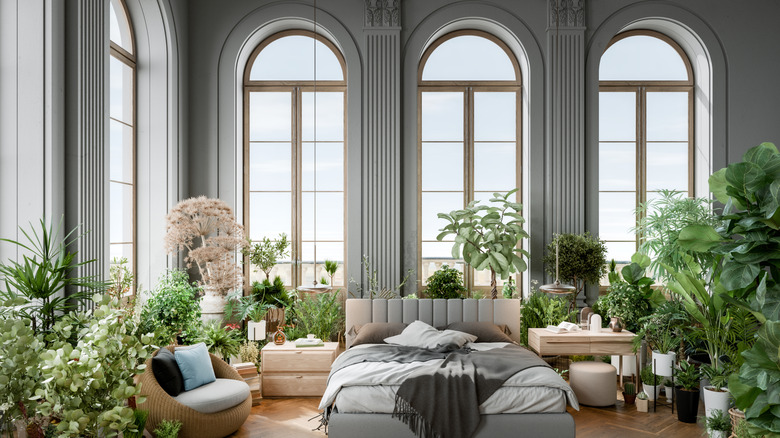Are In-Grown, Indoor Plant Beds A Good Idea, Or An Invitation For Pests?
Planting flowers and foliage in a raised bed to elevate a patio or back garden design is a tried-and-true technique. It turns out that this method may work equally as well indoors. HGTV tours of historic Tudor-style homes showcase rooms alive with indoor plant beds filled with greenery, and TikTok creators share the ways they implement DIY versions of the trend in their houses. But is nurturing a garden in indoor plant beds a good idea? Or is this interior design trend an invitation for unwanted visitors looking for somewhere to infest? The short answer is that pests can be a problem, but their visitations are preventable with regular maintenance and natural repellents. Plus, indoor plants can clean the air, improve your mood, and add charm to a room.
This isn't the first time bountiful indoor gardens have been a hot topic in interior design. In the past, people have used plants to create stunning living walls indoors. However, as perhaps should be expected, there are some risks that come with moving your garden indoors, and they may make this design choice a poor match for some homes and homeowners. The gardening technique involves arranging houseplants inside raised beds or permanent planter boxes. Large built-in gardens are truly high-brow and are often spotted in luxurious homes. Small indoor raised beds, on the other hand, are more approachable and don't require a pricey renovation. They can be beautiful and rewarding if executed correctly, but neglecting to consider potential problems like pest infestations could come back to bite you — literally.
How built-in garden beds could elevate your home's interior design
There is an abundance of benefits to indoor gardening, and choosing to grow plants in interior raised beds is a chic way to reap them. For starters, houseplants are protected from the elements, and you can experience extended growing seasons. You also have the freedom to choose plants you can't grow outdoors in your growing zone. Maintaining an indoor plant bed may also improve your home's air quality, especially if you have a lot of plants, which can positively impact you and your family's health. What's more, being surrounded by plants inside may boost creativity and mood. Adding a raised bed to a home office or bedroom could positively impact your productivity and mental health.
Choosing to grow an indoor garden in a single raised bed in a well-lit room is a practical and affordable alternative to buying lots of individual pots, especially if you prefer luxury or high-end designs. Dozens of houseplants in differently sized planters placed haphazardly around a room can feel cluttered, too. By contrast, plants arranged in neat rows in bespoke built-in beds feel positively harmonious. The idea is also unique — indoor planter boxes aren't something you see every day. They're a quirky feature that adds character and personality. Nature and sustainability are trending in home design right now, and there are fewer better ways to incorporate it than actual living plants.
The potential downsides to installing indoor raised beds in your home
Pests are one of the top things to consider before starting an indoor garden. When you bring plants inside, you also risk attracting pests that may find your indoor raised beds as attractive as you do. Some insects — like spider mites, mealybugs, and aphids, among others — are adept at finding their way indoors where they quickly make themselves right at home in your houseplants. Whether the plants are growing in pots or a built-in planter box doesn't matter to them in the slightest. While you can treat pests once they're in your home using handpicking, trapping, or natural or chemical insecticides, the better approach is to prevent their arrival.
Choose houseplant species and cultivars that are naturally resistant to pests or repel them — from smelly citronella plants to insect-eating Venus flytraps and pitcher plants. Some outdoor flowers you can grow to naturally keep bugs away from your home also thrive indoors, like lavender, French marigolds, and lemon balm, to name a few. Performing regular inspections, maintaining dry, leaf litter-free soil, and keeping your plants healthy by maintaining optimal growing conditions all help to keep pest problems under control. Overall, the risk of pests shouldn't discourage anyone thinking of installing a raised bed indoors.


